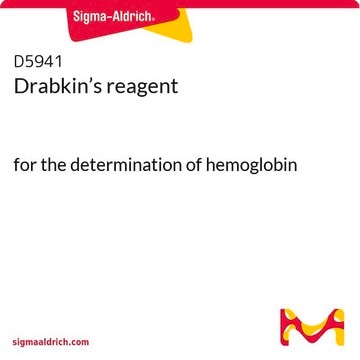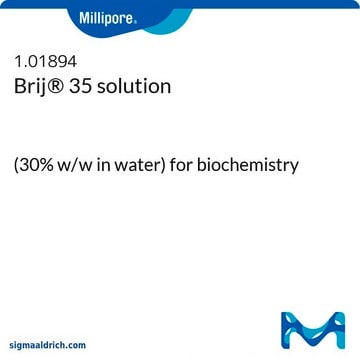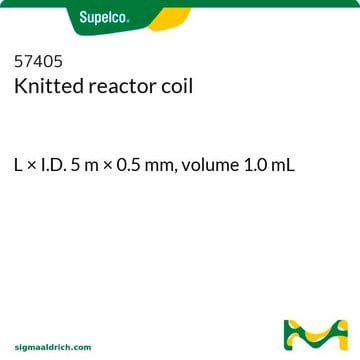If this product has an expiration or retest date, it will be shown on the Certificate of Analysis (COA, CofA). If there is no retest or expiration date listed on the product's COA, we do not have suitable stability data to determine a shelf life. For these products, the only date on the COA will be the release date; a retest, expiration, or use-by-date will not be displayed.
For all products, we recommend handling per defined conditions as printed in our product literature and website product descriptions. We recommend that products should be routinely inspected by customers to ensure they perform as expected.
For products without retest or expiration dates, our standard warranty of 1 year from the date of shipment is applicable.
For more information, please refer to the Product Dating Information document: https://www.sigmaaldrich.com/deepweb/assets/sigmaaldrich/marketing/global/documents/449/386/product-dating-information-mk.pdf
B4184
Brij® L23 solution
30 % (w/v) in H2O
Sinônimo(s):
Brij® 35 solution, C12E23, Polyoxyethylene (23) lauryl ether
About This Item
Produtos recomendados
fonte biológica
synthetic
Nível de qualidade
descrição
non-ionic
Formulário
liquid
peso molecular
~1198.0 g/mol
concentração
30 % (w/v) in H2O
número de agregação
40
CMC
91 μM
temperatura de transição
cloud point ≥100 °C
solubilidade
water: soluble
densidade
1.024 g/mL
HLB
16.9
cadeia de caracteres SMILES
CCCCCCCCCCCCOCCOCCOCCOCCOCCOCCOCCOCCOCCOCCOCCOCCOCCOCCOCCOCCOCCOCCOCCOCCOCCOCCOCCO
InChI
1S/C58H118O24/c1-2-3-4-5-6-7-8-9-10-11-13-60-15-17-62-19-21-64-23-25-66-27-29-68-31-33-70-35-37-72-39-41-74-43-45-76-47-49-78-51-53-80-55-57-82-58-56-81-54-52-79-50-48-77-46-44-75-42-40-73-38-36-71-34-32-69-30-28-67-26-24-65-22-20-63-18-16-61-14-12-59/h59H,2-58H2,1H3
chave InChI
IEQAICDLOKRSRL-UHFFFAOYSA-N
Procurando produtos similares? Visita Guia de comparação de produtos
Categorias relacionadas
Descrição geral
Aplicação
- as a supplement of De Man, Rogosa, Sharpe (MRS) broth for monitoring bacteriocin production by lactic acid bacteria(66)
- as a component of developing buffer for the incubation of zymogram gel for metalloproteinase quantification(67)
- as a component of activation buffer for recombinant human hepsin(68)
Ações bioquímicas/fisiológicas
Características e benefícios
Embalagem
Nota de preparo
Outras notas
Informações legais
produto comparável
Palavra indicadora
Warning
Frases de perigo
Declarações de precaução
Classificações de perigo
Aquatic Chronic 2 - Eye Irrit. 2 - Skin Irrit. 2
Código de classe de armazenamento
10 - Combustible liquids
Classe de risco de água (WGK)
WGK 2
Ponto de fulgor (°F)
Not applicable
Ponto de fulgor (°C)
Not applicable
Escolha uma das versões mais recentes:
Certificados de análise (COA)
Não está vendo a versão correta?
Se precisar de uma versão específica, você pode procurar um certificado específico pelo número do lote ou da remessa.
Já possui este produto?
Encontre a documentação dos produtos que você adquiriu recentemente na biblioteca de documentos.
Os clientes também visualizaram
Artigos
Cathepsin B is a lysosomal cysteine proteinase with broad specificity. This protocol uses Nα–CBZ–Arg–Arg–7–amido–4–methylcoumarin as the substrate for fluorometric detection of Cathepsin B activity.
-
How can I determine the shelf life / expiration / retest date of this product?
1 answer-
Helpful?
-
-
How is shipping temperature determined? And how is it related to the product storage temperature?
1 answer-
Products may be shipped at a different temperature than the recommended long-term storage temperature. If the product quality is sensitive to short-term exposure to conditions other than the recommended long-term storage, it will be shipped on wet or dry-ice. If the product quality is NOT affected by short-term exposure to conditions other than the recommended long-term storage, it will be shipped at ambient temperature. As shipping routes are configured for minimum transit times, shipping at ambient temperature helps control shipping costs for our customers. For more information, please refer to the Storage and Transport Conditions document: https://www.sigmaaldrich.com/deepweb/assets/sigmaaldrich/marketing/global/documents/316/622/storage-transport-conditions-mk.pdf
Helpful?
-
Active Filters
Nossa equipe de cientistas tem experiência em todas as áreas de pesquisa, incluindo Life Sciences, ciência de materiais, síntese química, cromatografia, química analítica e muitas outras.
Entre em contato com a assistência técnica










